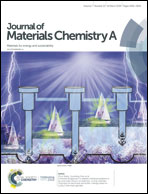The OH−-driven synthesis of Pt–Ni nanocatalysts with atomic segregation for alkaline hydrogen evolution reaction†
Abstract
Intense researches for pursuing effective catalysts for alkaline hydrogen evolution reaction (HER) have been carried out. Particularly, Pt-based materials having heterostructures have shown excellent electrocatalytic performance. However, there are only few investigations on the transformation from an alloy to a heterostructure and the main reason for superior activity. Herein, we demonstrated that Pt–Ni heterostructures could be formed by only introducing NaOH in the synthesis of Pt–Ni alloys. Density functional theory calculations revealed that the added OH− can influence the energy barriers of atomic reduction and migration, thus driving the formation of a heterostructure with atomic segregation. Moreover, it was proved that the enhanced HER performance is attributed to favorable H and OH energetics arising from the atomic segregation. Acid treatment emphasized the key factors in determining the activity. This work proves that adding OH− can lead to the formation of nanocatalysts with atomic segregation, and tuning the atomic segregation of Pt–Ni catalysts is an effective way to optimize their H and OH adsorption abilities, thus enhancing the alkaline HER performance.



 Please wait while we load your content...
Please wait while we load your content...